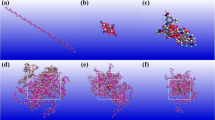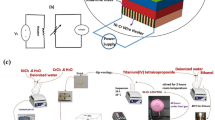Abstract
Hydrocalumite (HC) is a type of synthetic layered double hydroxide (LDH) that has many important industrial uses and is commonly synthesized by a co-precipitation method in a water:ethanol (2:3) mixture; however, atmospheric carbon dioxide interferes with the synthesis by decreasing the solubility of other gases in the reaction medium. The aim of the present study was to vary the temperature and aging time used in the coprecipitation method in order to mitigate the adverse effects of carbon dioxide. The water/ethanol mixture (2:3) was able to prevent atmospheric carbon dioxide contamination of the sample, as it decreased the solubility of the gas in the reaction mixture. Aging time (9–36 h) and temperature (35–95°C) were varied to modify the hydrocalumite structure, textural properties, thermal stability, and basicity. The characterization of the samples was performed using X-ray diffraction (XRD), X-ray fluorescence (XRF), Fourier-transform infrared spectroscopy (FTIR), nitrogen physisorption, thermogravimetric analysis (TGA), and CO2 temperature-programmed desorption (TPD-CO2) techniques. The aging time of 9 h and temperature of 95°C provided the most crystalline sample with the largest mean crystallite size (49 nm). The variation of the synthesis conditions also provided changes in the surface area (6.5–20.2 m2 g–1), pore diameter (116–148 Å), and pore volume (0.0147–0.0499 cm3 g–1). The temperature ranges for thermal decomposition of structural water and carbonate varied among the samples, indicating different thermal stabilities. The basicity (basic sites quantified by TPD-CO2) was also affected by the change in aging conditions; the sample aged for 9 h at 65°C presented the greatest basicity (1557 μmol g–1), whereas that aged for 36 h at 35°C had the least basicity (337 μmol g–1).












Similar content being viewed by others
REFERENCES
Barrado, E.P. (2015). Layered double hydroxides for applications in catalysis and electroluminescent devices. PhD thesis, Universitat Rovira I Virgili, 189 pp.
Cavani, F., Trifirò, F., & Vaccari, A. (1991). Hydrotalcite-type anionic clays: preparation, properties and applications. Catalysis Today, 11, 173–301.
Chen, H., Sun, Y., Ruan, X., Yu, Y., Zhu, M., Zhang, J., Zhou, J., Xu, Y., Liu, J., & Qian, G. (2016). Advanced treatment of stabilized landfill leachate after biochemical process with hydrocalumite chloride (Ca/Al-Cl LDH). Bioresource Technology, 210, 131–137.
Cota, I., Ramírez, E., Medina, F., Sueiras, J. E., Layrac, G., & Tichit, D. (2010). New synthesis route of hydrocalumite-type materials and their application as basic catalysts for aldol condensation. Applied Clay Science, 50, 498–502.
Domínguez, M., Pérez-Bernal, M. E., Ruano-Casero, R. J., Barriga, C., Rives, V., Ferreira, R. A. S., Carlos, L. D., & Rocha, J. (2011). Multiwavelength luminescence in lanthanide-doped hydrocalumite and mayenite. Chemistry of Materials, 23, 1993–2004.
Granados-Reyes, J., Salagre, P., & Cesteros, Y. (2014). Effect of microwaves, ultrasounds and interlayer anion on the hydrocalumites synthesis. Microporous and Mesoporous Materials, 199, 117–124.
Guo, Q., & Tian, J. (2013). Removal of fluoride and arsenate from aqueous solution by hydrocalumite via precipitation and anion exchange. Chemical Engineering Journal, 231, 121–131.
Hills, A. W. D. (1968). The mechanism of the thermal decomposition of calcium carbonate. Chemical Engineering Science, 23, 297–320.
Jia, Y., Wang, H., Zhao, X., Liu, X., Wang, Y., Fan, Q., & Zhou, J. (2016). Kinetics, isotherms and multiple mechanisms of the removal for phosphate by Cl-hydrocalumite. Applied Clay Science, 129, 116–121.
Kuwahara, Y., Tsuji, K., Ohmichi, T., Kamegawa, T., Mori, K., & Yamashita, H. (2012). Waste-slag hydrocalumite and derivatives as heterogeneous base catalysts. ChemSusChem, 5, 1523–1532.
Leroux, F., Léone, P., Besse, J.-P., Taviot-Guého, C., Palvadeau, P., & Rousselot, I. (2002). Insights on the structural chemistry of hydrocalumite and hydrotalcite-like materials: investigation of the series Ca2M3+(OH)6Cl·2H2O (M3+: Al3+, Ga3+, Fe3+, and Sc3+) by X-Ray Powder Diffraction. Journal of Solid State Chemistry, 167, 137–144.
Linares, C. F., Ocanto, F., Bretto, P., & Monsalve, M. (2014). Study of as-synthesized and calcined hydrocalumites as possible antacid agents. Bulletin of Materials Science, 37, 941–944.
Linares, C. F., Moscosso, J., Alzurutt, V., Ocanto, F., Bretto, P., & González, G. (2016). Carbonated hydrocalumite synthesized by the microwave method as a possible antacid. Materials Science and Engineering C, 61, 875–878.
López-Salinas, E., Serrano, M. E. L., Jácome, M. A. C., & Secora, I. S. (1996). Characterization of synthetic hydrocalumite-type [Ca2Al(OH)6]NO3·mH2O: Effect of the calcination temperature. Journal of Porous Materials, 2, 291–297.
Mao, N., Zhou, C. H., Tong, D. S., Yu, W. H., & Lin, C. X. C. (2017). Exfoliation of layered double hydroxide solids into functional nanosheets. Applied Clay Science, 144, 60–78.
Mao, N., Zhou, C. H., Keeling, J., Fiore, S., Zhang, H., Chen, L., Jin, G. C., Zhu, T. T., Tong, D. S., & Yu, W. H. (2018). Tracked changes of dolomite into Ca-Mg-Al layered double hydroxide. Applied Clay Science, 159, 25–36.
Marsal, L. F., Salagre, P., Díaz, F., Cesteros, Y., Pérez-Barrado, E., Aguiló, M., Llorca, J., Pujol, M. C., & Pallarès, J. (2015). Influence of acid–base properties of calcined MgAl and CaAl layered double hydroxides on the catalytic glycerol etherification to short-chain polyglycerols. Chemical Engineering Journal, 264, 547–556.
Oladoja, N. A., Adelagun, R. O. A., Ololade, I. A., Anthony, E. T., & Alfred, M. O. (2014). Synthesis of nano-sized hydrocalumite from a Gastropod shell for aqua system phosphate removal. Separation and Purification Technology, 124, 186–194.
Pérez-Barrado, E., Pujol, M. C., Aguiló, M., Cesteros, Y., Díaz, F., Pallarès, J., Marsal, L. F., & Salagre, P. (2013). Fast aging treatment for the synthesis of hydrocalumites using microwaves. Applied Clay Science, 80–81, 313–319.
Pfeiffer, H., Ávalos-Rendón, T., Lima, E., & Valente, J. S. (2011). Thermochemical and cyclability analyses of the CO2 absorption process on a Ca/Al layered double hydroxide. Journal of Environmental Engineering, 137, 1058–1065.
Prado, R. G., Almeida, G. D., De Oliveira, A. R., De Souza, P. M. T. G., Cardoso, C. C., Constantino, V. R. L., Pinto, F. G., Tronto, J., & Pasa, V. M. D. (2016). Ethanolysis and methanolysis of soybean and macauba oils catalyzed by mixed oxide Ca-Al from hydrocalumite for biodiesel production. Energy and Fuels, 30, 6662–6670.
Rossi, T. M., Campos, J. C., & Souza, M. M. V. M. (2019). An evaluation of calcined hydrocalumite as carbon dioxide adsorbent using thermogravimetric analysis. Applied Clay Science, 182, 105252–105261.
Roy, A., Forano, C., Malki, K. E., & Besse, J. P. (1992). Anionic clays: trends in pillaring chemistry. Expanded Clays and Other Microporous Solids, 2, 108–169.
Sánchez-Cantú, M., Camargo-Martínez, S., Pérez-Díaz, L. M., Hernández-Torres, M. E., Rubio-Rosas, E., & Valente, J. S. (2015). Innovative method for hydrocalumite-like compounds’ preparation and their evaluation in the transesterification reaction. Applied Clay Science, 114, 509–516.
Sánchez-Cantú, M., Barcelos-Santiago, C., Gomez, C. M., Ramos-Ramírez, E., Ruiz Peralta, M. d. L., Tepale, N., González-Coronel, V. J., Mantilla, A., & Tzompantzi, F. (2016). Evaluation of hydrocalumite-like compounds as catalyst precursors in the photodegradation of 2,4-dichlorophenoxyacetic acid. International Journal of Photoenergy, 2016, 1–13.
Terzis, A., Filippakis, S., Kuzel, H. J., & Burzlaff, H. (1987). The crystal structure of Ca2Al(OH)6Cl.2H2O. Zeitschrift für Kristallographie - Crystalline Materials, 181, 29–34.
Wen, X., Yang, Z., Yan, J., & Xie, X. (2015). Green preparation and characterization of a novel heat stabilizer for poly(vinyl chloride)-hydrocalumites. RSC Advances, 5, 32020–32026.
Wen, X., Yang, Z., Xiao, X., Yang, H., Xie, X., & Huang, J. (2016). The impact of hydrocalumites additives on the electrochemical performance of zinc-nickel secondary cells. Electrochimica Acta, 187, 65–72.
Wu, Y., Chi, Y., Bai, H., Qian, G., Cao, Y., Zhou, J., Xu, Y., Liu, Q., Xu, Z. P., & Qiao, S. (2010). Effective removal of selenate from aqueous solutions by the Friedel phase. Journal of Hazardous Materials, 176, 193–198.
Xu, S., Zhang, B., Chen, Z., Yu, J., Evans, D. G., & Zhang, F. (2011). A general and scalable formulation of pure CaAl-layered double hydroxide via an organic/water solution route. Industrial and Engineering Chemistry Research, 50, 6567–6572.
Zhang, P., Qian, G., Shi, H., Ruan, X., Yang, J., & Frost, R. L. (2012). Mechanism of interaction of hydrocalumites (Ca/Al-LDH ) with methyl orange and acidic scarlet GR. Journal of Colloid and Interface Science, 365, 110–116.
ACKNOWLEDGMENTS
The authors thank CAPES, CNPq, and FAPERJ for providing financial support for this study, and Greentec/EQ/UFRJ for N2 adsorption analyses.
Author information
Authors and Affiliations
Corresponding author
Ethics declarations
Conflict of Interest
The authors declare that they have no conflict of interest.
Rights and permissions
About this article
Cite this article
Rossi, T.M., Campos, J.C. & Souza, M.M.V.M. SYNTHESIS AND CHARACTERIZATION OF HYDROCALUMITE: INFLUENCE OF AGING CONDITIONS ON THE STRUCTURE, TEXTURAL PROPERTIES, THERMAL STABILITY, AND BASICITY. Clays Clay Miner. 68, 273–286 (2020). https://doi.org/10.1007/s42860-019-00049-6
Published:
Issue Date:
DOI: https://doi.org/10.1007/s42860-019-00049-6




